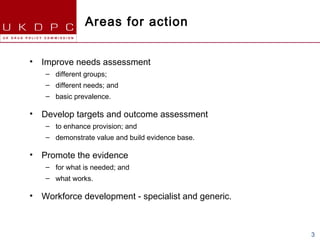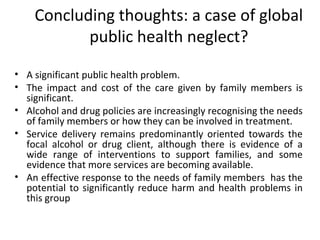Adfam- AlexCoppelloPP
- 1. Families and addiction: Stress, symptoms and coping responses Professor Alex Copello Birmingham and Solihull Mental Health Foundation Trust and University of Birmingham, UK Families First ÔÇô DDN, Adfam Conference Birmingham, Holiday Inn, 15th November 2012
- 2. it ought to be both surprising and shocking that there has been so little in the way of a co- ordinated response to families living with the drug problem of their son or daughter, brother or sister. Marina Barnard Drug Addiction and Families 2007, p. 51
- 3. Individual vs. social view of addictions
- 4. Despite the available evidence and potential gain, shifting the emphasis from individualised treatment approaches to those focused on the substance userÔÇÖs family and social environment presents a number of significant challenges (Copello, 2006)
- 5. A narrow individual focus on treatment and help fails to consider some well proven facts: ÔÇó That living with a significant alcohol or drug problem is a highly stressful experience ÔÇó That the stress experienced leads to physical and psychological symptoms for family members ÔÇó That family members use generic and primary care services to seek help ÔÇó That family members provide significant care (e.g. UKDPC) ÔÇó That family members can improve outcomes for the substance user
- 6. BARRIERS... to recognition and to accessing formal and informal support
- 7. Why work with families? 1. ÔÇÿCarer burdenÔÇÖ is extremely high and families need support in their own right ÔÇó Costs are financial, social, psychological, physical and relational ÔÇó Reciprocity of well-being ÔÇó Families indirectly influence relativesÔÇÖ using behaviour ÔÇó We need to consider the whole system of the family, not just the individual when thinking Recovery.
- 8. Why work with families? 2. Improved client treatment outcomes ÔÇó Increases client entry into treatment ÔÇó Improves engagement and retention of client in treatment ÔÇó Improves substance use outcomes for clients ÔÇó Reduces relapse ÔÇó Families play crucial role in facilitating recovery
- 9. The four most important people: how were they related to the drinkers? This graph shows how the participants were related to their four most important people. Frequencies of relationship type are shown for the 1st, 2nd, 3rd and 4th most important people to the drinker. 500 400 significant other frequency 300 family 200 friend 100 other 0 1 2 3 4 im portant person no. The majority of people entering alcohol treatment named their partner as the most important person, although family members were also a popular choice. Very few drinkers named their partner as least important person of the four. Members of close family were predominantly named as second or third most important, and friends were commonly named as third or fourth.
- 10. How large is the problem? It is estimated that there are approximately 15 million people with drug use disorders globally and 76 million with alcohol use disorders (Obot, 2005). A cautious estimate of just one person seriously affected in each case suggests a minimum of 91 million affected family members Most people would use a greater multiplier and produce a higher figure
- 11. What is the extent of the problem? ÔÇó Key findings from UK DPC study about adult family members of Drug treatment General drug misusers. population population ÔÇó What about alcohol misuse? ÔÇó Up to 1 million children are affected by parental drug misuse 50,373 partners 573,671 partners & up to 3.5 million by parental 55,012 parents 610,970 parents alcohol misuse (Manning et al., 35,208 ÔÇÿotherÔÇÖ 259,133 ÔÇÿotherÔÇÖ 2009). ÔÇó It is estimated that the impact of drug misuse on the family costs the UK ┬ú1.8 billion but also Total = 140,593 Total =1,443,774 brings a resource saving to the NHS of ┬ú747 million through the care provided.
- 12. An International Picture ÔÇó We have spoken directly to family members in: ÔÇô England ÔÇô Mexico City ÔÇô Australia (Aboriginal communities) ÔÇô Italy ÔÇó What we have been told suggests that the impact of substance misuse on the family is remarkably similar all over the world. ÔÇó Yet, particular elements of this experience can differ or be more prominent according to culture and social context. ÔÇó This experience seems to be similar to people who live with other traumas.
- 13. Main Modifiers of the Core Family Member Experience Family Material FM female circumstances or male Relationship Traditional vs THE CORE to misusing Modern family EXPERIENCE relative roles Is modified by Substances use Culture: pattern individual, familial or communal Licit or illicit: traditional or recently introduced
- 14. THE UNIQUE SET OF STRESSFUL CIRCUMSTANCES FOR FAMILIES COPING WITH ADDICTION ´ü▒ Has the nature of severe stress, threat and abuse ´ü▒ Involves multiple sources of threat to self and family, including emotional, social, financial, health and safety ´ü▒ Can have significant impact on children ´ü▒ Worry for that family member is a prominent feature ´ü▒ There are influences in the form of individual people and societal attitudes that encourage the troubling behaviour ´ü▒ Attempting to cope creates difficult dilemmas, and there is no guidance on the subject ´ü▒ Social support for the family is needed but tends to fail ´ü▒ Professionals who might help are often at best badly informed and at worst critical
- 15. Symptoms of Ill Health Family Family members; psychiatric out-pts. and members community controls 35 30 25 20 15 10 5 0 UK Wives Control Mexico P.Care P.Care Psych 1 2
- 16. Ray et al (2007) Compared family members of people with substance misuse problems with family members of similar persons without substance misuse. Samples: Family members n = 45,677 (male/female  46/54%) Comparison group n = 141,722 (male/female  46/54%) More likely to be diagnosed with medical conditions most commonly depression and other psychological problems Ray et al (2007) The excess medical cost Medical Care
- 17. Three Common ways of responding ÔÇÿPutting up with itÔÇÖ ÔÇÿStanding up to itÔÇÖ ÔÇÿWithdrawing/IndependenceÔÇÖ
- 18. What happens in practice?
- 19. Practice Ôû║ Some very good examples of services for family members but provision is patchy Ôû║ Implementation of evidence based practice is low Ôû║ Potential to improve availability and response to families
- 20. We know that family members have two related needs: To receive advice and support on their own right To be supportive of the relativeÔÇÖs treatment and involved if useful
- 21. ÔÇ£Being thereÔÇØ ÔÇ£Give adviceÔÇØ ÔÇ£Being a strengthÔÇØ ÔÇ£Day to dayÔÇØ ÔÇ£Continuity of supportÔÇØ ÔÇ£Your timeÔÇØ ÔÇ£UnderstandingÔÇØ ÔÇ£ChallengesÔÇØ
- 22. 5-Step Method ÔÇó 1 ÔÇô Listen, reassure and explore concerns ÔÇó 2 - Give relevant targeted information (eg substances, treatment, support) ÔÇó 3 - Explore coping responses ÔÇô ÔÇÿengagedÔÇÖ, ÔÇÿtolerantÔÇÖ, ÔÇÿwithdrawnÔÇÖ ÔÇó 4 ÔÇô Discuss social support ÔÇô map ÔÇó 5 ÔÇô Discuss further support needs
- 23. TRANSFORMATIONS DESCRIBED BY FAMILY MEMBERS RECEIVING 5-STEPS IN PRIMARY CARE ÔÇó Increased focus on own life and needs (gaining independence) ÔÇó Increased assertiveness over the misuse (resisting and being assertive) ÔÇó Taking a calmer approach towards the misusing relative (reduced emotional confronting) ÔÇó Increased awareness of the relativeÔÇÖs misuse problem and its effects on family members (cognitive change)
- 24. Key message: A little support can have wide positive consequences
- 25. But most important: Seeing family members as partners in the challenging task of helping people change addictive behaviours
- 26. UKDPC research on adult family /carers Phase 2: 2011-12 Aims ÔÇóTo describe the extent and nature of support provision for adult family members / carers of people experiencing drug problems to highlight gaps and good practice to help improve provision. Components: ÔÇóReview of policy & guidance in the UK ÔÇóWeb survey of service providers in the UK ÔÇóIn-depth study: 20 DAT areas in England & 8 ADPs in Scotland Research team: Alex Copello, Lorna Templeton, Gagandeep Chohan & Trevor McCarthy 2
- 27. Policy review findings [Note: Unpublished ÔÇô please do not quote without permission] ÔÇó Increased level of recognition of families in policy & guidance BUT ÔÇó ÔÇÿFamiliesÔÇÖ generally = children of substance-using parents ÔÇó Little consideration of sub-groups of adult family members & their varying needs ÔÇó More focus on involvement in treatment than help in own right ÔÇó Lack of detail on what needs to be provided ÔÇó Little consideration of monitoring quality or extent of provision ÔÇó Need more recognition in strategies in related policy areas (eg criminal justice; DV). 3
- 28. Web survey findings [Note: Unpublished ÔÇô please do not quote without permission] Characteristics of services ÔÇó253 services from across the UK (70% non-statutory) 145 - England 71 - Scotland 22 - N Ireland 14 - Wales ÔÇóType of service 58% = Part of service for substance misusers 24% = Service solely for adult family members 10% = Part of generic carers service 8% = Other ÔÇóWho worked with 89% = Drugs and alcohol59% = Families alongside drug users 11% = Drugs only 41% = Adult family member only 3
- 29. Web survey findings [Note: Unpublished ÔÇô please do not quote without permission] Support to family members on their own Counselling 48% Bereavement 29% Co-dependency-based 22% 5-step method 9% 12-step support 7% CRAFT 1% PACT (1) Family therapy (1) 3
- 30. Web survey findings [Note: Unpublished ÔÇô please do not quote without permission] Support for family members and drug users together 3
- 31. Areas for action ÔÇó Improve needs assessment ÔÇô different groups; ÔÇô different needs; and ÔÇô basic prevalence. ÔÇó Develop targets and outcome assessment ÔÇô to enhance provision; and ÔÇô demonstrate value and build evidence base. ÔÇó Promote the evidence ÔÇô for what is needed; and ÔÇô what works. ÔÇó Workforce development - specialist and generic. 3
- 32. Concluding thoughts: a case of global public health neglect? ÔÇó A significant public health problem. ÔÇó The impact and cost of the care given by family members is significant. ÔÇó Alcohol and drug policies are increasingly recognising the needs of family members or how they can be involved in treatment. ÔÇó Service delivery remains predominantly oriented towards the focal alcohol or drug client, although there is evidence of a wide range of interventions to support families, and some evidence that more services are becoming available. ÔÇó An effective response to the needs of family members has the potential to significantly reduce harm and health problems in this group
- 33. Thank you for ▒¶¥▒▓§│┘▒▓È¥▒▓È▓ÁÔǪ
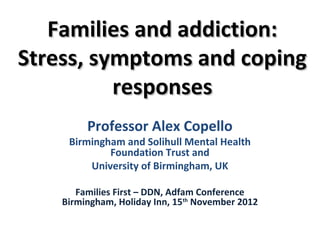
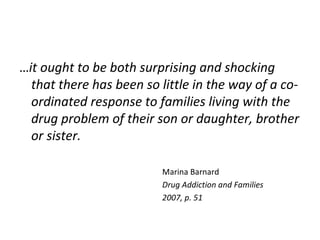
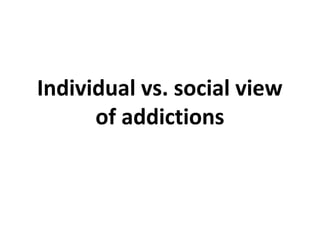
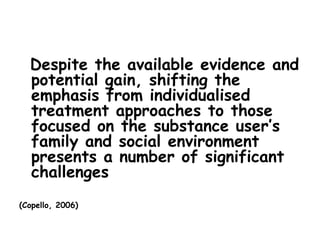
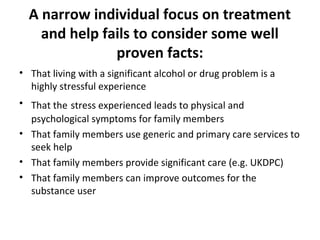
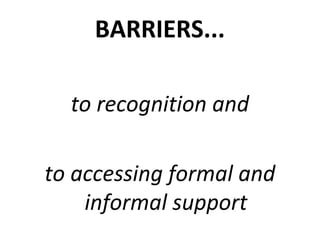
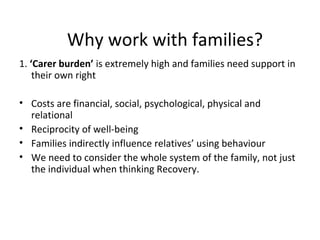
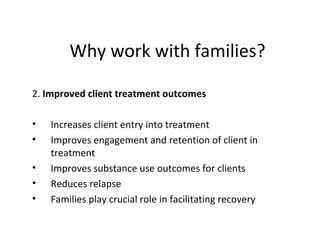
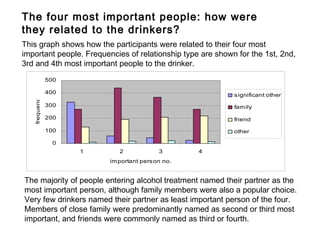
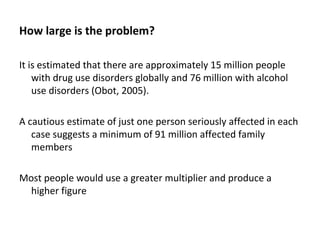
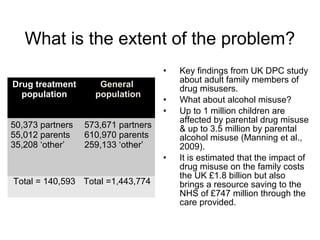
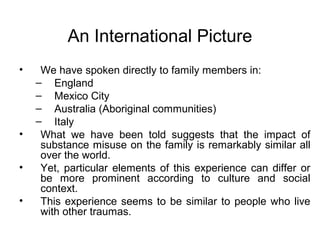
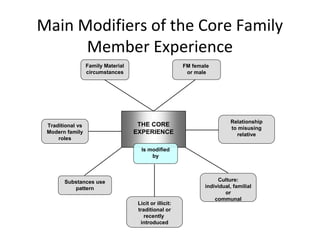
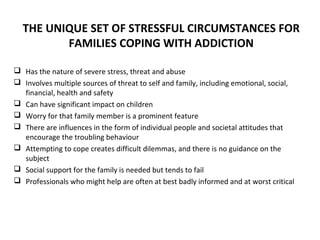
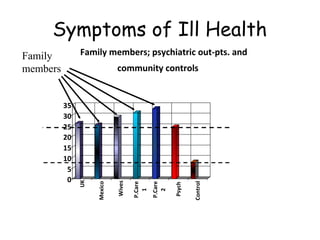
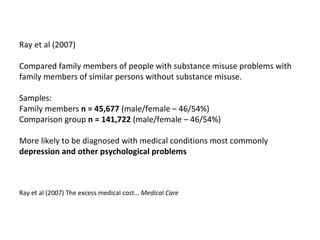
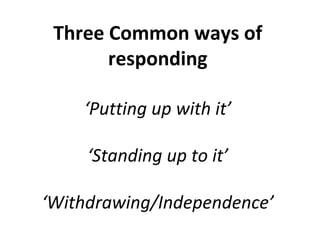

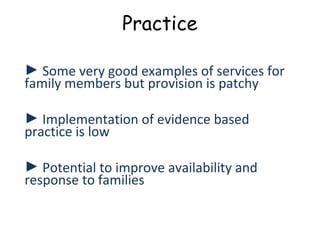

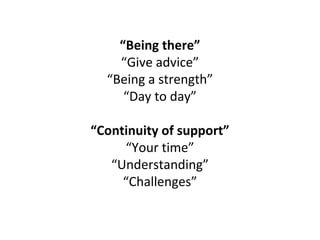
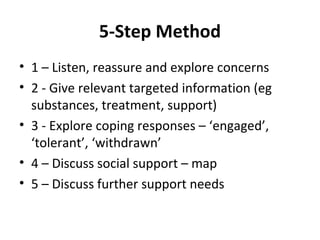
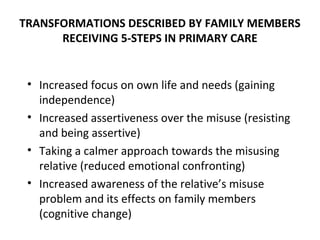
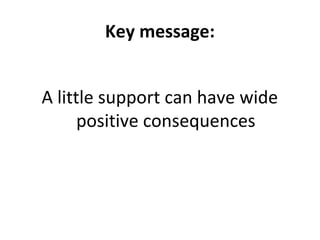
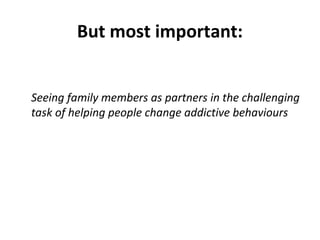
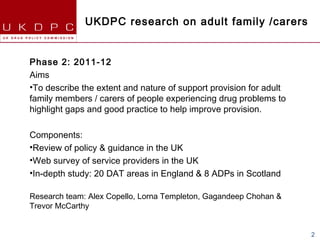
![Policy review findings
[Note: Unpublished ÔÇô please do not quote without permission]
ÔÇó Increased level of recognition of families in policy & guidance
BUT
ÔÇó ÔÇÿFamiliesÔÇÖ generally = children of substance-using parents
ÔÇó Little consideration of sub-groups of adult family members &
their varying needs
ÔÇó More focus on involvement in treatment than help in own right
ÔÇó Lack of detail on what needs to be provided
ÔÇó Little consideration of monitoring quality or extent of provision
ÔÇó Need more recognition in strategies in related policy areas (eg
criminal justice; DV).
3](https://image.slidesharecdn.com/coppello-121120071157-phpapp02/85/Adfam-AlexCoppelloPP-27-320.jpg)
![Web survey findings
[Note: Unpublished ÔÇô please do not quote without permission]
Characteristics of services
ÔÇó253 services from across the UK (70% non-statutory)
145 - England
71 - Scotland
22 - N Ireland
14 - Wales
ÔÇóType of service
58% = Part of service for substance misusers
24% = Service solely for adult family members
10% = Part of generic carers service
8% = Other
ÔÇóWho worked with
89% = Drugs and alcohol59% = Families alongside drug users
11% = Drugs only 41% = Adult family member only
3](https://image.slidesharecdn.com/coppello-121120071157-phpapp02/85/Adfam-AlexCoppelloPP-28-320.jpg)
![Web survey findings
[Note: Unpublished ÔÇô please do not quote without permission]
Support to family members on their own
Counselling 48%
Bereavement 29% Co-dependency-based 22%
5-step method 9%
12-step support 7%
CRAFT 1%
PACT (1)
Family therapy (1)
3](https://image.slidesharecdn.com/coppello-121120071157-phpapp02/85/Adfam-AlexCoppelloPP-29-320.jpg)
![Web survey findings
[Note: Unpublished ÔÇô please do not quote without permission]
Support for family members and drug users together
3](https://image.slidesharecdn.com/coppello-121120071157-phpapp02/85/Adfam-AlexCoppelloPP-30-320.jpg)
